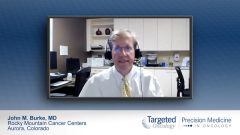
Next Steps Using Anti-CD19 Therapies in DLBCL
The future of combined treatment approaches with anti-CD19 therapies for diffuse large B-cell lymphoma.
Episodes in this series

Marin F. Xavier, MD: We’ve covered most of the clinically important stuff. We have some questions about the lymphodepletion and promising up-front therapies. We already discussed what’s most clinically important. We talked about the sequencing. Let’s move on to the future options in terms of what you’re excited about. I already hinted about what I’m excited about, and you’ve educated a lot about some trials that are going to be reporting out, especially for front line. Anything that excites you for large cell lymphoma in the coming months to years?
John M. Burke, MD: As you mentioned, the bispecific antibodies are probably first on most everyone’s minds. We saw 4 or 5 of them reported out at ASH [American Society of Hematology Annual Meeting] last year and some more follow-up from the summer meeting, so it will be exciting to hear more at ASH this year. That’s probably No. 1. High up there, as you mentioned, are some of the off-the-shelf cellular therapy products: T-cell and even NK [natural killer]–cell therapies. I hope it’s as easy as just seeing great efficacy of those things and then making cellular therapy more available to more people. That would solve a lot of problems, especially with some of the reduced toxicity problems that are being seen. It seems that’s a potential therapy that could be delivered more widely than CAR [chimeric antigen receptor] T. The biggest problem with CAR T is that it’s hard to get. It’s hard to get patients there and hard to get patients that treatment. There are a number of other novel therapies out there. One that’s crossed my radar screen is targeting the CD47-SIRPα interaction. There are antibodies being developed at both of those targets showing some potential for promise, particularly in combination. We’ll see how that turns out. How about you? Anything else high on your radar?
Marin F. Xavier, MD: Yeah, CD47 is interesting in many malignancies as a different type of immunotherapy using phagocytosis. Thanks for bringing that up. I’m excited to see how that pans out in terms of will that be another tool in our toolbox. You and I mentioned previously bispecifics. There’s 1 that’s also a subcutaneous and that seems to be pretty manageable. I’m comfortable doing bispecifics even in the ALL [acute lymphocytic leukemia] setting, even not being a transplant center. That’s really promising as a salvage therapy and also in combination with front line. They’re both going to have some potential improvements on our standards and be fairly accessible in the community.
What are your pearls for the community hematologist-oncologists who may see diffuse large B-cell lymphoma [DLBCL]? That’s our final question.
John M. Burke, MD: Do you want to start? Go ahead.
Marin F. Xavier, MD: The pearl is that we have long-term disease control and a lot more therapies that work for a significant duration of time in the second- and third-line settings. That’s my mantra. It’s no longer life and death, and it’s possible to live with decent quality of life with relapsed diffuse large B-cell lymphoma. That’s where I find a lot of hope. I see a lot of geriatrics, so it’s been fun to have this new role to palliate.
John M. Burke, MD: I can’t say it any better than that. The other thing I’ll add is that, all of a sudden, we have all these new agents. That’s a fairly uncommon scenario for us oncologists to be facing relapsed DLBCL. We have more treatment options now than you can possibly use as a community doctor. It’s hard to be an expert on all these and to get experience with all these. Nobody can use a ton of tafasitamab, a ton of loncastuximab, and a ton of selinexor and polatuzumab. Going back to a point you made earlier about contacting your local or regional expert in the field and finding somebody you can trust and work with to help manage these patients is important to make sure your patients are getting the right treatment.
Marin F. Xavier, MD: Thank you so much. They chose both of us for a reason. We’re community doctors who happen to see a lot of lymphomas, and not depriving the opportunity for cure and working with your cellular therapy programs is quite important. This has been extremely informative for me. I hope our audience agrees. Dr. Burke, you’ve been such a wonderful discussant. Thank you so much to the audience for watching this Targeted Oncology™presentation of “CD19 as a Target in the Treatment of Diffuse Large B-cell Lymphoma.”We hope you found this to be useful, as I did, and we thank you for inviting us for this opportunity.
John M. Burke, MD: Thanks so much. This was a lot of fun.
Transcript edited for clarity.








































